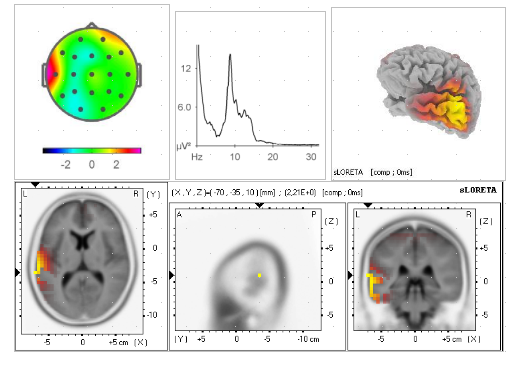The qEEG consists of two parts of evaluation, the first of them, the patient must remain at rest with eyes closed for four minutes while recording his signal. In the second part the patient must remain another four minutes with his eyes open. Once these two tasks have been completed, we go to the registry of evoked potentials.
To register evoked potentials, the patient must perform a specific task in front of a monitor. This task consists of pressing a key before the appearance of certain elements and not pressing it before others. This task is performed for 20 minutes in which the brain activity is recorded in response to the need to respond or inhibit the response in the task.

Brain activity tomography sLORETA.

Mapping of the brain activity record.
ADHD
Excess of theta and frontal beta in the analysis of qEEG
Low amplitude of the p300 component in GO condition
ASD
Frontal beta excess in the qEEG analysis in case of poor performance ASD
Affected the novelty component in the analysis of evoked potentials
TOC
Excess beta in the midline centered on the analysis of qEEG
Affected the late component of p300 in the analysis of evoked potentials.
Depression
Frontal alpha asymmetry and some presence of excess beta in the qEEG analysis
Deleted the executive control component of the p300 in NOGO condition of the evoked potential analysis.
Anxiety
Increase of beta in the central midline
Increase of positive and negative components in the analysis of evoked potentials.
Insomnia
Decay of alpha, appearance of theta and paroxysms in the analysis of qEEG
Dementia
Decay of alpha and increase of frontal theta in the analysis of qEEG
Decreasing of the bicomponent of the p300 in the analysis of evoked potentials.